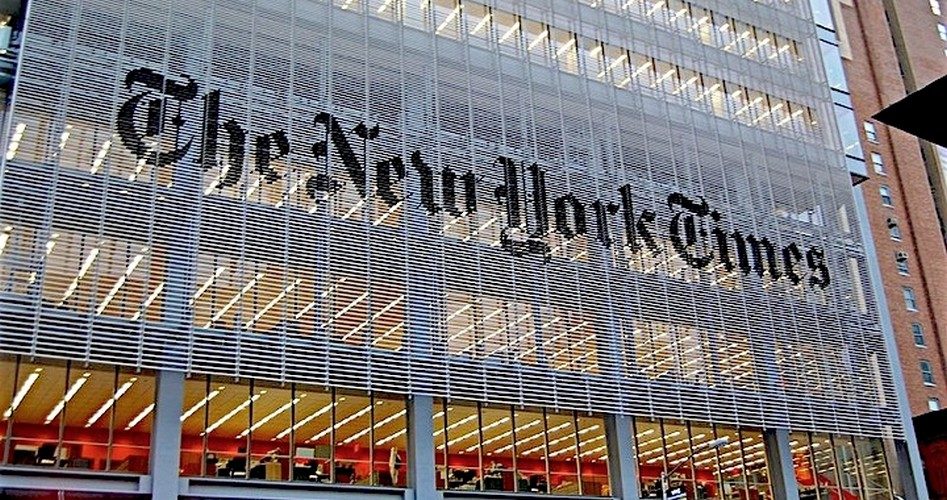
In his final column as Public Editor of the New York Times, Arthur S. Brisbane concluded that “the paper’s many departments … share a kind of political and cultural progressivism … that virtually bleeds through the fabric of The Times.” But it’s certainly not because of any conspiracy, just a meeting of like minds in promoting a worldview that editors and writers share: urbane, worldly, and flexible. Wrote Brisbane:
I … noted two years ago that I had taken up the public editor duties believing “there is no conspiracy” and that The Times’ output was too vast and complex to be dictated by any Wizard of Oz-like individual or cabal.
I still believe that, but also see that the hive on Eighth Avenue is powerfully shaped by a culture of like minds — a phenomenon, I believe, that is more easily recognized from without than from within…
As a result, developments like the Occupy movement and gay marriage seem almost to erupt in The Times, over loved and undermanaged, more like causes than news subjects.
Brisbane was the fourth public editor to take on the task of handling complaints about the Times’ reporting on various issues and then writing about them every couple of weeks. He is a self-proclaimed Democrat with all the proper liberal credentials: stints at the Kansas City Star and the Washington Post, and the requisite degree from Harvard.
When he arrived on the scene he viewed his role as that of coroner, called in to do autopsies on “flawed new articles that drew complaints.” And there were plenty. So many, in fact, that The Times’ “believability rating” at Pew Research Center continues to decline, in contrast to that of Fox News. Asked Brisbane: “Can that be good?”
Brisbane echoes the liberal view of the paper expressed by the Times’ Executive Editor Bill Keller last fall when he said, “We are liberal in the sense that we are open-minded, tolerant, urban. Our wedding page includes…gay unions. So we’re liberal in that sense.”
But a previous public editor, Daniel Okrent, went much deeper into the bias, especially as it related to gay unions. Wrote Okrent:
For those who also believe the news pages cannot retain their credibility unless all aspects of an issue are subject to robust examination, it’s disappointing to see The Times present the social and cultural aspects of same-sex marriage in a tone that approaches cheerleading…
[From recent articles in The Times] I’ve learned where gay couples go to celebrate their marriages; I’ve met gay couples picking out bridal dresses; I’ve been introduced to couples who have been together for decades and have now sanctified their vows in Canada, couples who have successfully integrated the world of competitive ballroom dancing, couples whose lives are the platonic model of suburban stability.
Every one of these articles was perfectly legitimate. Cumulatively, though, they would make a very effective ad campaign for the gay marriage cause. You wouldn’t even need the articles: run the headlines over the invariably sunny pictures of invariably happy people that ran with most of these pieces, and you’d have the makings of a life insurance commercial.
What’s left out of the discussion, however, is revealing. What about the deleterious effect gay marriage is having on heterosexual marriage? What is the impact on tax revenues? Or research on child-rearing in gay families? Noted Okrent:
In The Times, I have learned next to nothing about these issues, nor about partner abuse in the gay community, about any social difficulties that might be encountered by children of gay couples or about divorce rates…
In other words, on this issue, the reader is abysmally uninformed if all he does is read the Times.
But the progressive “bleed through” infects every aspect of the paper. Wrote Okrent:
Start with the editorial page, so thoroughly saturated in liberal theology that when it occasionally strays from that point of view the shocked yelps from the left overwhelm even the ceaseless rumble of disapproval from the right…
In the Sunday magazine, the culture-wars applause-o-meter chronically points left.
On the Arts & Leisure front page every week [columnists] … slice up … paladins of the right…
Creationists should expect to find [little] comfort in Science Times.
Newspapers have the right to decide what’s important and what’s not. But their editors must also expect that some readers will think: ”This does not represent me or my interests. In fact, it represents my enemy.” So is it any wonder that the offended or befuddled reader might consider everything else in the paper — including, say, campaign coverage — suspicious as well?
To careful readers of the current political scene, such revelations only confirm their suspicions. What’s most revealing is that these revelations are coming from the inside, by editors tasked with responding to the paper’s critics. After two years inside, Brisbane has stated the obvious: The New York Times is biased in favor of a progressive worldview, and it’s not likely to change any time soon.



